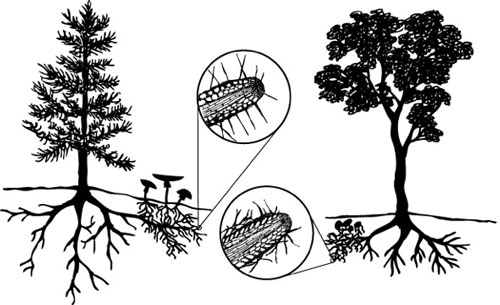The word convergence typically describes convergent evolution, the independent evolution of similar traits in different lineages resulting from strong selective pressures. As Darwin wrote in The Origin of Species “…[a]nimals, belonging to two most distinct lines of descent, may readily become adapted to similar conditions, and thus assume a close external resemblance…”. Convergence also plays a role in ecology; the resemblance of entire communities of plants in the Mediterranean climates of California, Chile, South Africa and the Mediterranean Basin are examples of community convergence, defined as the physiognomic similarity of geographically distant assemblages of species.

Figure: ectomycorrhizal associations.
We recognize that interactions among organisms also appear as convergent, and define the concept of convergent interactions. For example, mycorrhizae are symbioses between fungi and plants: the fungi supply scarce resources to plants in exchange for carbon. Mycorrhizae have evolved independently at least a dozen times, and in every case, a diagnostic root tip morphology emerges. Recognizing root tips as the hallmark of a convergent interaction between a fungus and plant will enable any biologist to understand the ecological roles of fungus and plant whenever a root tip is unearthed, no matter how remote the tropical forest or obscure the species involved. Other convergent interactions include the mutualisms of ant-plants and plant-ants independently evolved in Africa, South America and Asia, as well as the very specific microbial communities that enable foregut fermentation within animals as distantly related as the hoatzin bird and cow.
Root tips encompass a network of fungal tissues growing within the root, and networks are likely to facilitate the movement and exchange of resources between symbionts. Understanding how fluids move within and across fungal networks is critical to understanding how a fungus integrates stimuli and uses and transmits information to make decisions about when to associate with a plant, the proportion of resources to share, and perhaps even when to shift from mutualism to parasitism. Fungi are modular, iterated, indeterminate organisms, and the mechanisms enabling a fungus to function as an individual remain a mystery. These questions are the subject of our ongoing HFSP grant “Fluid flows and resource integration across networks formed by foraging, basal eukaryotes”.
Reference
Convergence in Multispecies Interactions. Bittleston LS, Pierce NE, Ellison AM, Pringle A.Trends Ecol Evol. 2016 Apr;31(4):269-80. doi: 10.1016/j.tree.2016.01.006. Epub 2016 Feb 6.


































